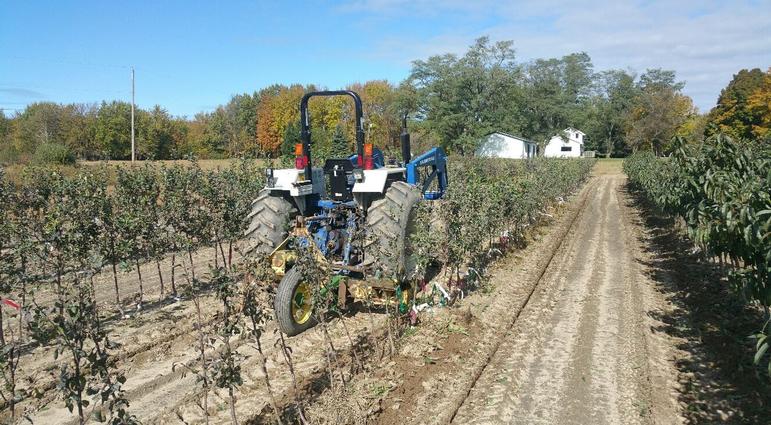How Grandpa Harvests and Stores Fruit Trees

Fruit trees don’t just jump out of the ground. In order for Grandpa to have trees ready for spring a lot of sweat and work is required.
Almost all fruit trees planted are “bare root” trees. Very few ever are grown entirely in a pot and sold to the final customer. Most potted trees at garden centers and big box stores almost always started out as bare root trees.
It takes from 2-3 years in the nursery cycle to grow a fruit tree. The first year is when the rootstock is planted and then budded or grafted. The second year, the bud or graft continues to grow into a fruit tree. Many nurseries in warm, long season climates can grow a nice fruit tree in that second year, but if the season and climate is a little too cool, then another year may be needed.
Once trees have hardened off in the fall, Grandpa starts the digging process. Many of the nurseries that Grandpa works with have really expensive “diggers, but Grandpa was lucky enough to find a good digger at an auction that works just fine for him. The digging process is hard, sweaty work even with a tractor and digging blade under cutting and “shaking” or “lifting” the trees.
Grandpa uses a 70+ horsepower, 4-wheel drive tractor to pull his “side-digger”. Most nurseries have either side-diggers or over-the-row Caterpillar type tractors which straddle the row. Needless to say, the over-the-row tractors are mighty expensive!
Grandpa will line up on the row to be undercut and shaken, drop the digger down and allow it to dig into the earth to a set level, activate the shaking mechanism, and head down the row. It doesn’t take long to undercut and shake a row of trees. This is really the easy part!
Grandpa dug about 6000 trees this Fall, and he was lucky to have enough helpers to pull, shake off the dirt, bundle, tie, and rack up all those trees in 3 days. It helped that the weather was cooperating — not too cold or windy and no rain. After Grandpa undercuts a row, the helpers have to follow behind and pull the trees up and out of the ground, shake them to take as much dirt off the roots as possible, and then lay them down into bundles. Someone then follows along and ties them into bundles. Another person will follow them and put the bundles into pallet racks. There is a lot of heavy work and sweating going on! Grandpa sure appreciates it when he has enough help to make the digging season go swiftly.
After racking the trees, we make sure the roots stay damp and then haul them to our cold storage a little ways away. The full racks are placed into a 40 degree cold room where we can keep the humidity high so that the roots do not dry out. When we have all the trees dug and in the cold storage, then we will start the grading process.
Remember when we dug the trees, we either bundled them into loose bundles, or if there were a lot of the same variety/rootstock combination, we layered them into the racks and tied them off from other varieties. It is so important to maintain variety/rootstock combination identity and integrity! No one likes it if the tree they planted in their orchard ends up to be something other than what they thought they bought because of some slip up. Because Grandpa has been in the nursery business all his life, he is particularly fussy about trueness to name. Finding an “orphan” tree somewhere without a label and not knowing what it actually is sets his temper to flaring pretty good!
Trees are graded according to standards which usually rely on the caliper of the variety just above the bud union. So, the grader uses a gauge to measure the tree and sort it into the proper grades. After a while a good grader becomes so adept at visualizing the size by just looking at it, that they may only need to measure a tree now and then to make sure their “eye ball” is accurate.
Once graded for size and quality, then the trees are re-bundled into sizes, labeled for identity (variety/root) and then put back into the storage for long-term care. All this time, the trees are watched carefully to not dry out while being graded.
There are several methods of storing trees. In the old days many nurseries had storage yards where trees were “healed” into the soil. If trees are dug in the spring or if the nursery is in a very moderate climate, this may still be done. But most nurseries now have gone to fully, climate controlled cold storage at about 36 degrees so that they can keep their trees out of the vagaries of Mother Nature and maintain their dormancy for long periods.
Grandpa heals his trees into beds in the cold storage and mulches them with wood shavings. Even with the small number of trees he grows, this method can eat up a lot of floor space. So, some big commercial nurseries heal trees in racks with sawdust and then stack the racks in huge climate controlled warehouses. Many others will store trees bare root in racks where the trees are laid down horizontally into bins.
I tell you there is nothing like the fine smell of a huge warehouse of racked up bare root trees! Perhaps when Grandpa was 10 and first went into the storage at the nursery that his father sold for, he was imprinted just like a duck gets imprinted to think his “mother” is the first thing he sees! At heart, I have always been a fruit tree nurseryman.